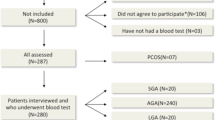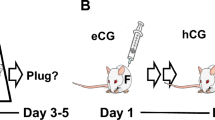Abstract
IT has been postulated1–3 that a waning corpus luteum in the presence of a developing follicle is necessary to produce œstrus in the ewe. One attempt to test this hypothesis by treating the anœstrous ewe with 2–5 mgm. progesterone before gonadotrophin injection yielded negative results1. Pretreatment with 40–100 mgm. testosterone propionate has resulted in some 75 per cent incidence of œtrus following pregnant mare serum injection4; but rates of conception are low. This low conception is due to either suppression of ovulation or to faulty synchronization between ovulation and œstrus3.
This is a preview of subscription content, access via your institution
Access options
Subscribe to this journal
Receive 51 print issues and online access
$199.00 per year
only $3.90 per issue
Buy this article
- Purchase on Springer Link
- Instant access to full article PDF
Prices may be subject to local taxes which are calculated during checkout
Similar content being viewed by others
References
Hammond, jun, J., Hammond, J., and Parkes, A. S., J. Agric. Sci., 32, 308 (1942).
Hammond, jun, J., J. Endocrinol., 4, 169 (1945).
Robinson, T. J., J. Agric. Sci., 40, 275 (1950).
Cole, H. H., Hart, G. H., and Miller, R. F., Endocrin., 36, 370 (1945).
Polovceva, V. V., and Judovic, S. S., Trud. Inst. Ovcevod Kozovod, 10, 125 (1939).
Author information
Authors and Affiliations
Rights and permissions
About this article
Cite this article
ROBINSON, T. Role of Progesterone in the Mating Behaviour of the Ewe. Nature 170, 373–374 (1952). https://doi.org/10.1038/170373a0
Issue Date:
DOI: https://doi.org/10.1038/170373a0
This article is cited by
-
Progesteron, sein Schicksal im Organismus und seine Anwendung in der Therapie
Klinische Wochenschrift (1955)
-
Relationship of Œstrogen and Progesterone in Œstrous Behaviour of the Ewe
Nature (1954)
Comments
By submitting a comment you agree to abide by our Terms and Community Guidelines. If you find something abusive or that does not comply with our terms or guidelines please flag it as inappropriate.



